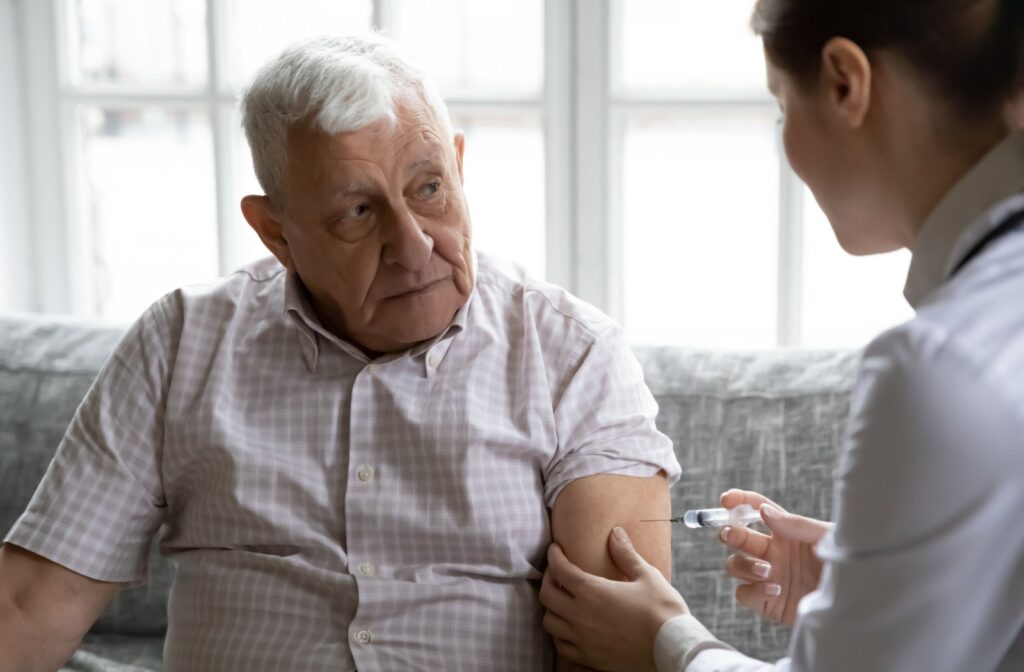While living with any level of pain is a challenge, chronic pain can feel like a continuous battle – one that can seem to have no end in sight. It often prevents individuals from enjoying day-to-day activities and can affect their overall health.
For many patients, traditional oral medications may not provide sufficient relief, and a different method of care is required. Chronic pain injection treatments such as Trigger Point Injections, involve releasing pain medication into injection sites to relieve pain, swelling, or irritation. Other forms of injections include Prolotherapy, Platelet Rich Plasma (PRP) Injections, and Botox. Chronic pain management can also help reduce dependency on pain medication.
What Is Chronic Pain?
Chronic pain is any form of persistent discomfort that continues beyond 3 months, the usual amount of time healing or pain usually lasts. It can be continuous or episodic and can range from mild to incapacitating.
Chronic pain can result without a known cause, after a healed injury, and even after treatment for a condition. There are 2 types of chronic pain:
- Chronic primary pain: Pain that persists after complete healing of injured structures.
- Chronic secondary pain: Pain occurs with an underlying disease or issue, such as cancer treatment, post-surgical pain, or rheumatoid arthritis.
Chronic Pain Injection Treatments
The quest to manage and reduce chronic pain often leads patients to seek out new avenues of treatment. Injection treatments for chronic pain management involve delivering medication directly to the source of the pain. This localized approach often means a smaller dose of the medication is needed, which can result in fewer side effects compared to oral drugs.
Types of Injections
There are several types of injections used to manage chronic pain, including the following:
- Corticosteroids: These powerful anti-inflammatory drugs, such as cortisone shots, are administered directly into joints or the inflamed area to reduce swelling and pain.
- Botox injections: Known primarily for its cosmetic uses, Botox can also help treat chronic migraines, muscle spasms, and certain types of pain.
- Trigger point injections: These injections can provide long-term pain relief for chronic muscle pain when inserted in a specific spot in a muscle.
- Prolotherapy: This is a safe and effective injection therapy that stimulates the body’s natural healing response to strengthen injured ligaments, tendons, and joints.
- Platelet Rich Plasma (PRP) Injections: The concentrated PRP is injected into the injured area, stimulating the body’s natural healing processes and promoting long-term healing.
Frequency of Injections
The frequency of injections varies depending on the condition treated and the specific injection being used, as well as t extent of their condition and the body’s response to treatment.
How Chronic Pain Injection Treatment Works
Before the injection, an experienced clinician or nurse practitioner will review your medical history and conduct a physical exam to see if you are a good candidate for the procedure. On the day of treatment, you’ll be positioned to allow your clinician to access the precise location of the injection.
The skin will be cleaned and sterilized before the injection to prevent infection. The injection itself usually involves a local anesthetic to numb the area before administering the medication.
After the injection, you’ll be monitored for a short period for no adverse reactions. You’ll receive instructions on post-procedure care, including any restrictions on activity and when to come back for a follow-up appointment.
Who Can Benefit from Injection Treatments?
Chronic pain injection treatments can help manage a range of conditions, such as:
- Arthritis
- Fibromyalgia
- Pelvic pain
- Musculoskeletal pain
- Tendon and ligament injuries
- Headaches
It’s important to note that chronic pain injection treatments are not a cure but a means of managing symptoms. They can be part of a comprehensive pain management plan.
Chronic Pain Management Program
Chronic pain management can include exercise, rest, nutrition, meditation, and breathing techniques as a healthy way to help manage pain, reduce dependency on pain medication, reduce the impact of pain on mental health, and improve quality of life.
Seeking Professional Advice
Before considering chronic pain injection treatments, it’s essential to consult with an experienced clinician. They can provide a detailed assessment of your condition and help you understand if injection treatments are appropriate. They will also discuss the benefits and risks of injections.
Based on your needs, they can also recommend alternative treatments. It’s vital to be open and honest with them about your medical history, current treatments, and your expectations for pain management so you can receive a tailored treatment plan and personalized care.
Maximizing Quality of Life
Chronic pain injection treatments can be a beacon of hope for individuals who have been struggling to find relief. By targeting the source of the pain, these procedures can offer improved quality of life and help patients rediscover the joy of everyday activities.
If you have chronic pain and are considering treatment, book an appointment with Running Shoe Restorative Healthcare for a knowledge-based approach and tested treatments.





